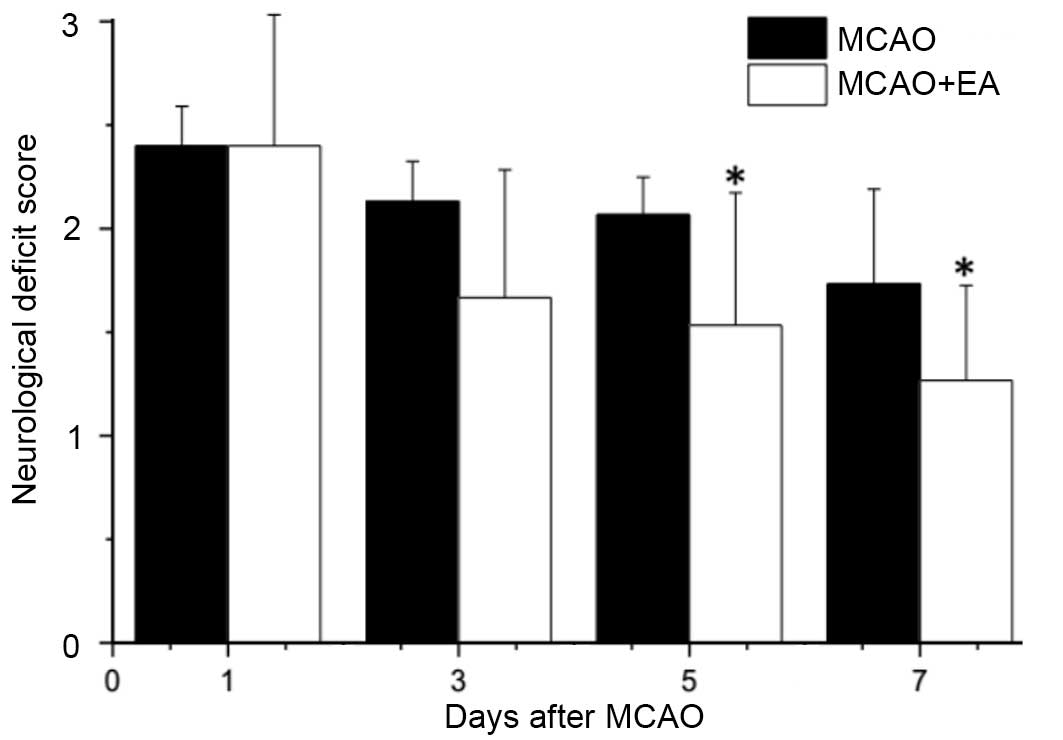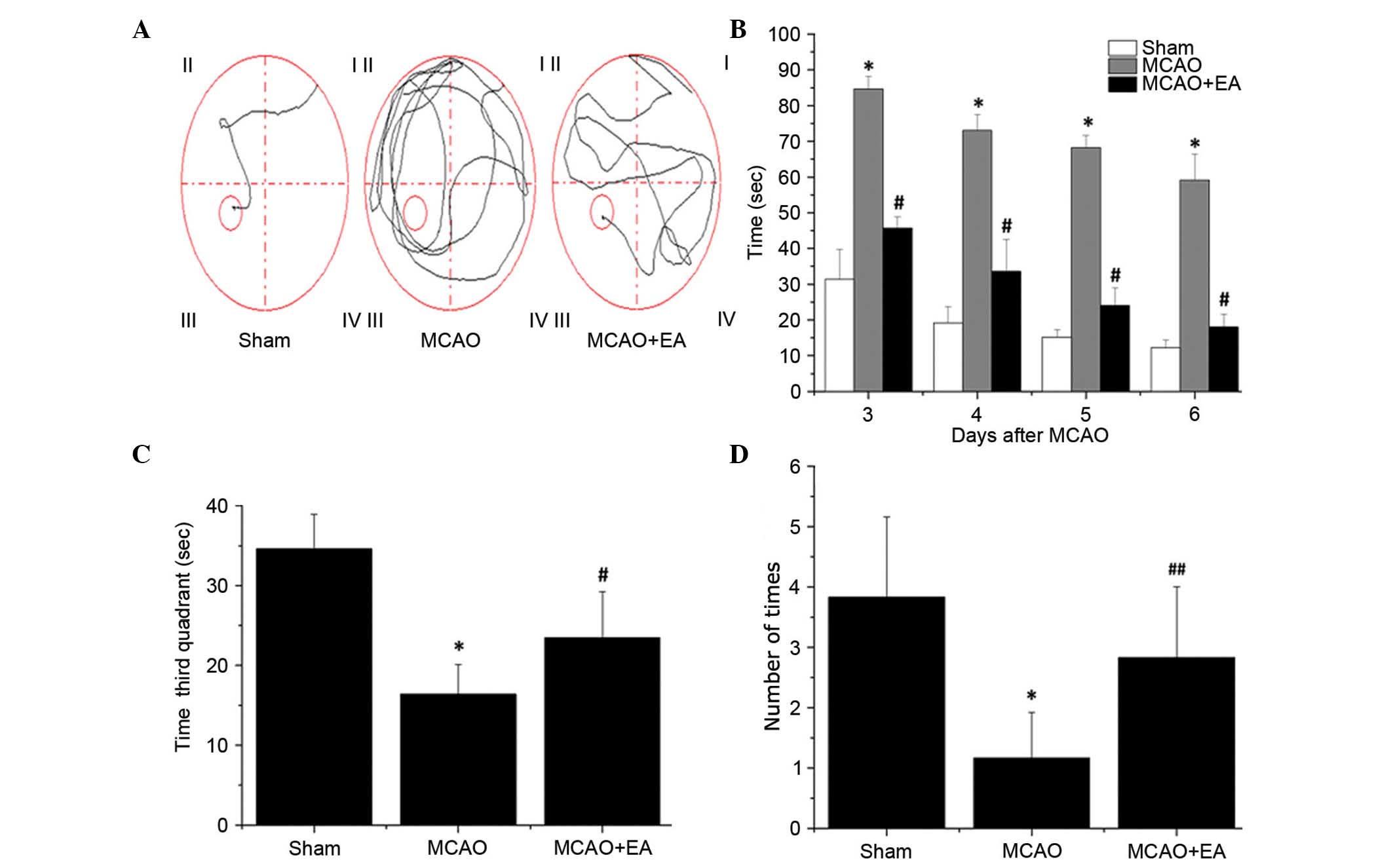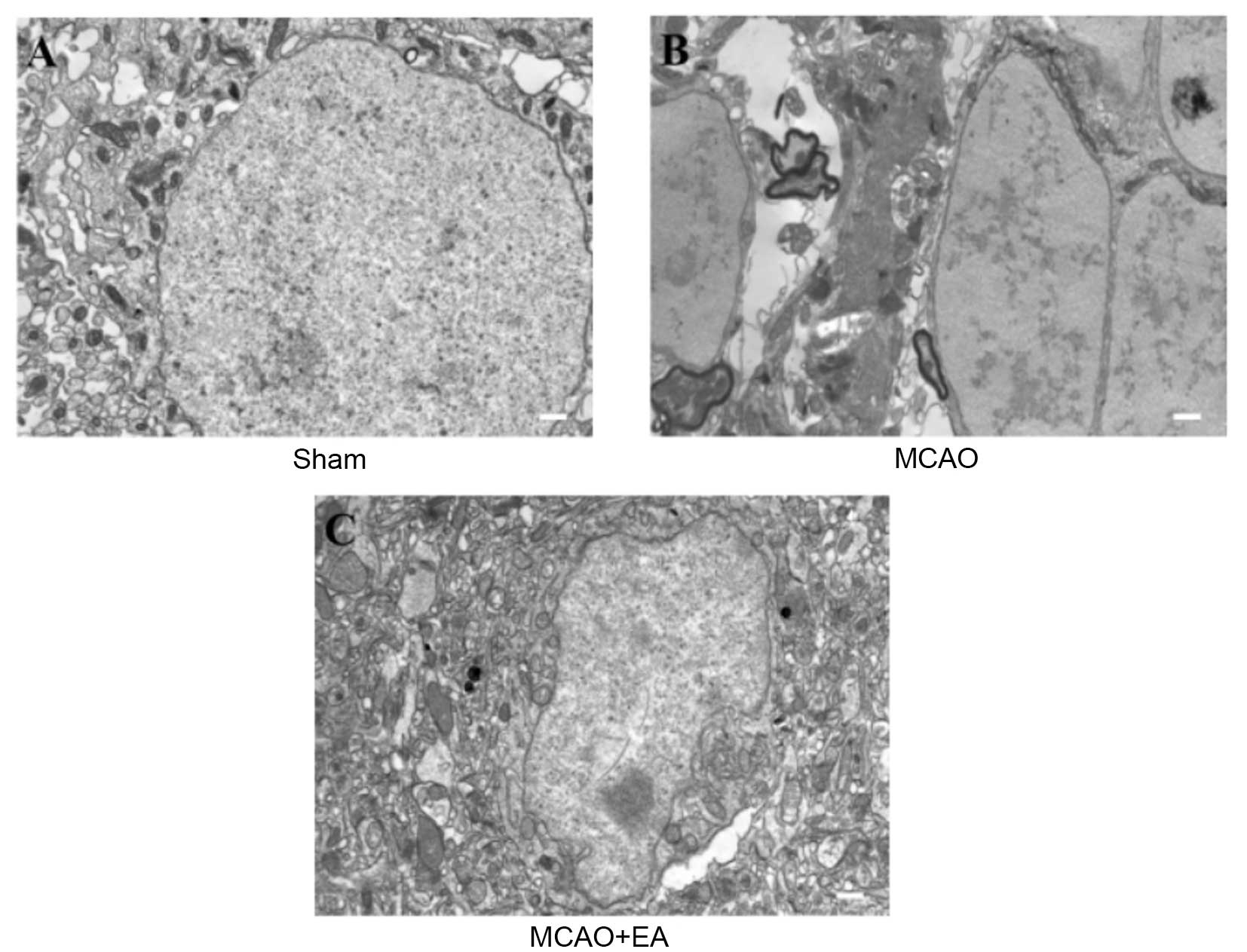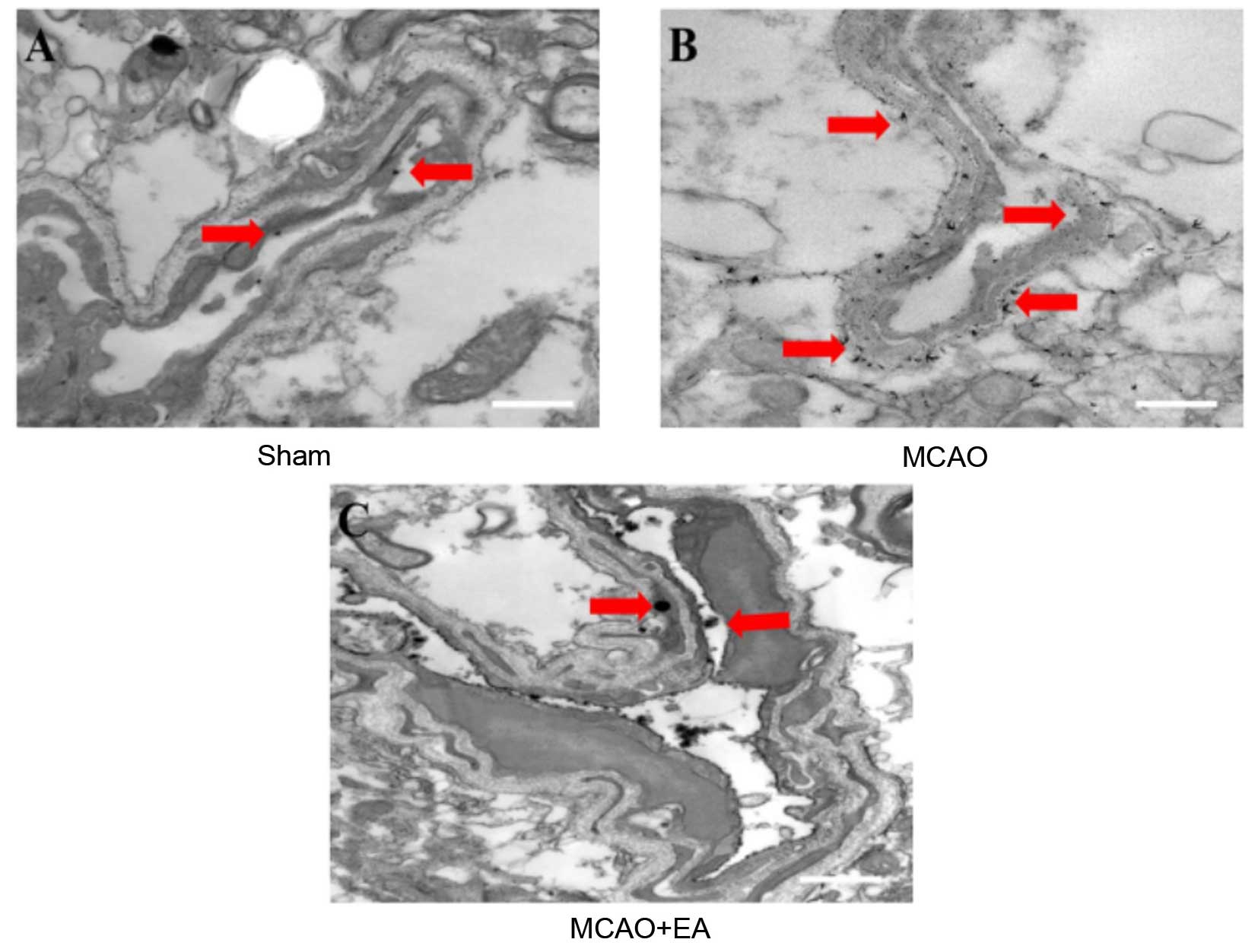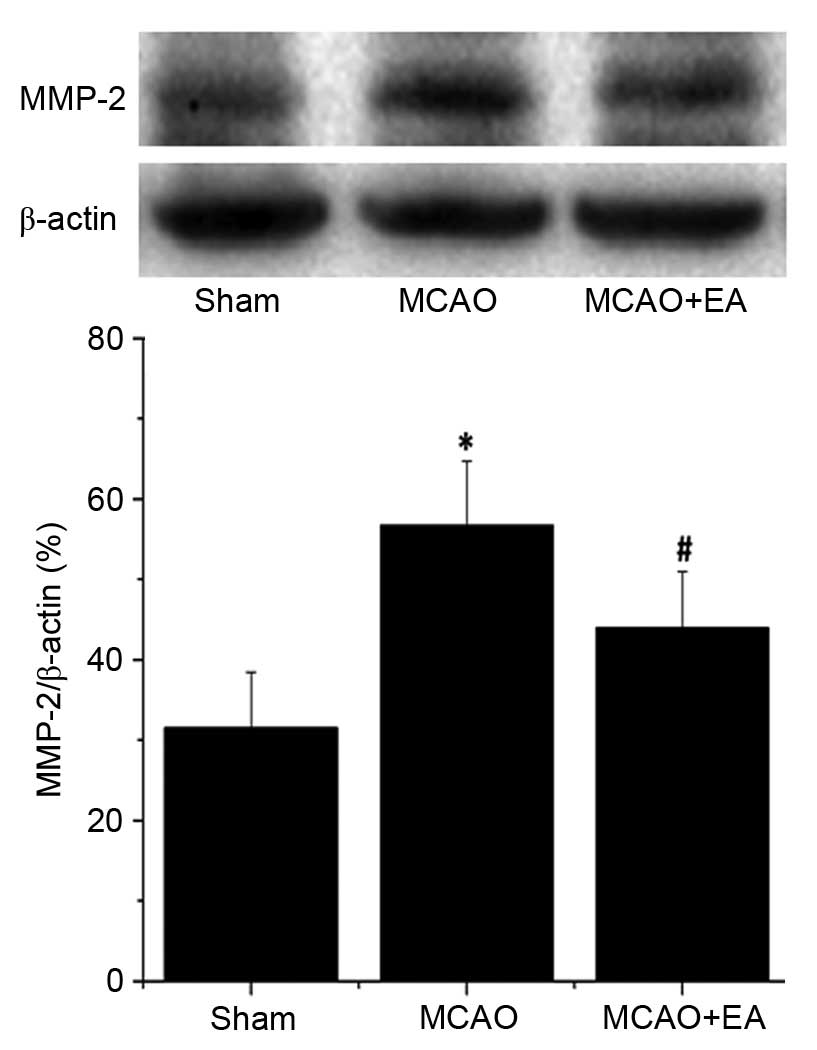|
1
|
Donnan GA, Fisher M, Macleod M and Davis
SM: Stroke. Lancet. 371:1612–1623. 2008. View Article : Google Scholar : PubMed/NCBI
|
|
2
|
Miniño AM, Murphy SL, Xu J and Kochanek
KD: Deaths: Final data for 2008. Natl Vital Stat Rep. 59:1–126.
2011.
|
|
3
|
Hachinski V, Iadecola C, Petersen RC,
Breteler MM, Nyenhuis DL, Black SE, Powers WJ, DeCarli C, Merino
JG, Kalaria RN, et al: National institute of neurological disorders
and stroke-canadian stroke network vascular cognitive impairment
harmonization standards. Stroke. 37:2220–2241. 2006. View Article : Google Scholar : PubMed/NCBI
|
|
4
|
Park JH, Kim BJ, Bae HJ, Lee J, Lee J, Han
MK, O KY, Park SH, Kang Y, Yu KH and Lee BC: Impact of post-stroke
cognitive impairment with no dementia on health-related quality of
life. J Stroke. 15:49–56. 2013. View Article : Google Scholar : PubMed/NCBI
|
|
5
|
Ovbiagele B, Goldstein LB, Higashida RT,
Howard VJ, Johnston SC, Khavjou OA, Lackland DT, Lichtman JH, Mohl
S, Sacco RL, et al: Forecasting the future of stroke in the United
States: A policy statement from the American heart association and
American stroke association. Stroke. 44:2361–2375. 2013. View Article : Google Scholar : PubMed/NCBI
|
|
6
|
Pendlebury ST and Rothwell PM: Prevalence,
incidence and factors associated with pre-stroke and post-stroke
dementia: A systematic review and meta-analysis. Lancet Neurol.
8:1006–1018. 2009. View Article : Google Scholar : PubMed/NCBI
|
|
7
|
Kim SK and Bae H: Acupuncture and immune
modulation. Auton Neurosci. 157:38–41. 2010. View Article : Google Scholar : PubMed/NCBI
|
|
8
|
Jittiwat J and Wattanathorn J: Ginger
pharmacopuncture improves cognitive impairment and oxidative stress
following cerebral ischemia. J Acupunct Meridian Stud. 5:295–300.
2012. View Article : Google Scholar : PubMed/NCBI
|
|
9
|
Zhang GC, Fu WB, Xu NG, Liu JH, Zhu XP,
Liang ZH, Huang YF and Chen YF: Meta analysis of the curative
effect of acupuncture on post-stroke depression. J Tradit Chin Med.
32:6–11. 2012. View Article : Google Scholar : PubMed/NCBI
|
|
10
|
Cao H, Wang Y, Chang D, Zhou L and Liu J:
Acupuncture for vascular mild cognitive impairment: A systematic
review of randomised controlled trials. Acupunct Med. 31:368–374.
2013. View Article : Google Scholar : PubMed/NCBI
|
|
11
|
Feng Y, Bai L, Ren Y, Chen S, Wang H,
Zhang W and Tian J: FMRI connectivity analysis of acupuncture
effects on the whole brain network in mild cognitive impairment
patients. Magn Reson Imaging. 30:672–682. 2012. View Article : Google Scholar : PubMed/NCBI
|
|
12
|
Zhang H, Zhao L, Yang S, Chen Z, Li Y,
Peng X, Yang Y and Zhu M: Clinical observation on effect of scalp
electroacupuncture for mild cognitive impairment. J Tradit Chin
Med. 33:46–50. 2013. View Article : Google Scholar : PubMed/NCBI
|
|
13
|
Lin YW and Hsieh CL: Electroacupuncture at
baihui acupoint (GV20) reverses behavior deficit and long-term
potentiation through N-methyl-d-aspartate and transient receptor
potential vanilloid subtype 1 receptors in middle cerebral artery
occlusion rats. J Integr Neurosci. 9:269–282. 2010. View Article : Google Scholar : PubMed/NCBI
|
|
14
|
Wang WW, Xie CL, Lu L and Zheng GQ: A
systematic review and meta-analysis of baihui (GV20)-based scalp
acupuncture in experimental ischemic stroke. Sci Rep.
4:39812014.PubMed/NCBI
|
|
15
|
Feng X, Yang S, Liu J, Huang J, Peng J,
Lin J, Tao J and Chen L: Electroacupuncture ameliorates cognitive
impairment through inhibition of NF-κB-mediated neuronal cell
apoptosis in cerebral ischemia-reperfusion injured rats. Mol Med
Rep. 7:1516–1522. 2013.PubMed/NCBI
|
|
16
|
Yang S, Ye H, Huang J, Tao J, Jiang C, Lin
Z, Zheng G and Chen L: The synergistic effect of acupuncture and
computer-based cognitive training on post-stroke cognitive
dysfunction: A study protocol for a randomized controlled trial of
2×2 factorial design. BMC Complement Altern Med. 14:2902014.
View Article : Google Scholar
|
|
17
|
Jin R, Song Z, Yu S, Piazza A, Nanda A,
Penninger JM, Granger DN and Li G: Phosphatidylinositol-3-kinase
gamma plays a central role in blood-brain barrier dysfunction in
acute experimental stroke. Stroke. 42:2033–2044. 2011. View Article : Google Scholar : PubMed/NCBI
|
|
18
|
Balami JS, Chen RL, Grunwald IQ and Buchan
AM: Neurological complications of acute ischaemic stroke. Lancet
Neurol. 10:357–371. 2011. View Article : Google Scholar : PubMed/NCBI
|
|
19
|
Abbott NJ, Patabendige AA, Dolman DE,
Yusof SR and Begley DJ: Structure and function of the blood-brain
barrier. Neurobiol Dis. 37:13–25. 2010. View Article : Google Scholar
|
|
20
|
Krueger M, Härtig W, Reichenbach A,
Bechmann I and Michalski D: Blood-brain barrier breakdown after
embolic stroke in rats occurs without ultrastructural evidence for
disrupting tight junctions. PLoS One. 8:e564192013. View Article : Google Scholar : PubMed/NCBI
|
|
21
|
Bao Dang Q, Lapergue B, Tran-Dinh A,
Diallo D, Moreno JA, Mazighi M, Romero IA, Weksler B, Michel JB,
Amarenco P and Meilhac O: High-density lipoproteins limit
neutrophil-induced damage to the blood-brain barrier in vitro. J
Cereb Blood Flow Metab. 33:575–582. 2013. View Article : Google Scholar : PubMed/NCBI
|
|
22
|
Spatz M: Past and recent BBB studies with
particular emphasis on changes in ischemic brain edema: Dedicated
to the memory of Dr. Igor Klatzo. Acta Neurochir Suppl. 106:21–27.
2010. View Article : Google Scholar
|
|
23
|
Yang D, Li SY, Yeung CM, Chang RC, So KF,
Wong D and Lo AC: Lycium barbarum extracts protect the brain from
blood-brain barrier disruption and cerebral edema in experimental
stroke. PLoS One. 7:e335962012. View Article : Google Scholar : PubMed/NCBI
|
|
24
|
Kasai H, Fukuda M, Watanabe S,
Hayashi-Takagi A and Noguchi J: Structural dynamics of dendritic
spines in memory and cognition. Trends Neurosci. 33:121–129. 2010.
View Article : Google Scholar : PubMed/NCBI
|
|
25
|
Barr TL, Latour LL, Lee KY, Schaewe TJ,
Luby M, Chang GS, El-Zammar Z, Alam S, Hallenbeck JM, Kidwell CS
and Warach S: Blood-brain barrier disruption in humans is
independently associated with increased matrix metalloproteinase-9.
Stroke. 41:e123–e128. 2010. View Article : Google Scholar
|
|
26
|
Jin R, Yang G and Li G: Molecular insights
and therapeutic targets for blood-brain barrier disruption in
ischemic stroke: Critical role of matrix metalloproteinases and
tissue-type plasminogen activator. Neurobiol Dis. 38:376–385. 2010.
View Article : Google Scholar : PubMed/NCBI
|
|
27
|
Chen W, Hartman R, Ayer R, Marcantonio S,
Kamper J, Tang J and Zhang JH: Matrix metalloproteinases inhibition
provides neuroprotection against hypoxia-ischemia in the developing
brain. J Neurochem. 111:726–736. 2009. View Article : Google Scholar : PubMed/NCBI
|
|
28
|
Longa EZ, Weinstein PR, Carlson S and
Cummins R: Reversible middle cerebral artery occlusion without
craniectomy in rats. Stroke. 20:84–91. 1989. View Article : Google Scholar : PubMed/NCBI
|
|
29
|
Tao J, Chen B, Gao Y, Yang S, Huang J,
Jiang X, Wu Y, Peng J, Hong Z and Chen L: Electroacupuncture
enhances hippocampal NSCs proliferation in cerebral
ischemia-reperfusion injured rats via activation of notch signaling
pathway. Int J Neurosci. 124:204–212. 2014. View Article : Google Scholar
|
|
30
|
Shim H: Vascular cognitive impairment and
post-stroke cognitive deficits. Curr Neurol Neurosci Rep.
14:4182014. View Article : Google Scholar
|
|
31
|
Fu YK, Chang CJ, Chen KY, Hwang LC, Wu KH,
Chang KW, Jan ML, Chen CC and Chang CH: Imaging of regional
metabolic activity by (18) F-FDG/PET in rats with transient
cerebral ischemia. Appl Radiat Isot. 67:1743–1747. 2009. View Article : Google Scholar : PubMed/NCBI
|
|
32
|
Boyko M, Kutz R, Gruenbaum BF, Cohen H,
Kozlovsky N, Gruenbaum SE, Shapira Y and Zlotnik A: The influence
of aging on poststroke depression using a rat model via middle
cerebral artery occlusion. Cogn Affect Behav Neurosci. 13:847–859.
2013. View Article : Google Scholar : PubMed/NCBI
|
|
33
|
Wang ZZ, Zhang Y, Liu YQ, Zhao N, Zhang
YZ, Yuan L, An L, Li J, Wang XY, Qin JJ, et al: RNA
interference-mediated phosphodiesterase 4D splice variants
knock-down in the prefrontal cortex produces antidepressant-like
and cognition-enhancing effects. Br J Pharmacol. 168:1001–1014.
2013. View Article : Google Scholar :
|
|
34
|
de Souza Silva MA, Lenz B, Rotter A,
Biermann T, Peters O, Ramirez A, Jessen F, Maier W, Hüll M,
Schröder J, et al: Neurokinin3 receptor as a target to predict and
improve learning and memory in the aged organism. Proc Natl Acad
Sci USA. 110:15097–15102. 2013. View Article : Google Scholar : PubMed/NCBI
|
|
35
|
Langdon KD, Granter-Button S, Harley CW,
Moody-Corbett F, Peeling J and Corbett D: Cognitive rehabilitation
reduces cognitive impairment and normalizes hippocampal CA1
architecture in a rat model of vascular dementia. J Cereb Blood
Flow Metab. 33:872–879. 2013. View Article : Google Scholar : PubMed/NCBI
|
|
36
|
D'Intino G, Paradisi M, Fernandez M,
Giuliani A, Aloe L, Giardino L and Calzà L: Cognitive deficit
associated with cholinergic and nerve growth factor down-regulation
in experimental allergic encephalomyelitis in rats. Proc Natl Acad
Sci USA. 102:3070–3075. 2005. View Article : Google Scholar : PubMed/NCBI
|
|
37
|
Leung MC, Yip KK, Ho YS, Siu FK, Li WC and
Garner B: Mechanisms underlying the effect of acupuncture on
cognitive improvement: A systematic review of animal studies. J
Neuroimmune Pharmacol. 9:492–507. 2014. View Article : Google Scholar : PubMed/NCBI
|
|
38
|
Greggio S, de Paula S, de Oliveira IM,
Trindade C, Rosa RM, Henriques JA and DaCosta JC: NAP prevents
acute cerebral oxidative stress and protects against long-term
brain injury and cognitive impairment in a model of neonatal
hypoxia-ischemia. Neurobiol Dis. 44:152–159. 2011.PubMed/NCBI
|
|
39
|
Pop V, Sorensen DW, Kamper JE, Ajao DO,
Murphy MP, Head E, Hartman RE and Badaut J: Early brain injury
alters the blood-brain barrier phenotype in parallel with β-amyloid
and cognitive changes in adulthood. J Cereb Blood Flow Metab.
33:205–214. 2013. View Article : Google Scholar
|
|
40
|
Pillai DR, Shanbhag NC, Dittmar MS,
Bogdahn U and Schlachetzki F: Neurovascular protection by targeting
early blood-brain barrier disruption with neurotrophic factors
after ischemia-reperfusion in rats. J Cereb Blood Flow Metab.
33:557–566. 2013. View Article : Google Scholar : PubMed/NCBI
|
|
41
|
Block ML, Zecca L and Hong JS:
Microglia-mediated neurotoxicity: Uncovering the molecular
mechanisms. Nat Rev Neurosci. 8:57–69. 2007. View Article : Google Scholar
|
|
42
|
Leonardo CC, Eakin AK, Ajmo JM, Collier
LA, Pennypacker KR, Strongin AY and Gottschall PE: Delayed
administration of a matrix metalloproteinase inhibitor limits
progressive brain injury after hypoxia-ischemia in the neonatal
rat. J Neuroinflammation. 5:342008. View Article : Google Scholar : PubMed/NCBI
|
|
43
|
Manso H, Krug T, Sobral J, Albergaria I,
Gaspar G, Ferro JM, Oliveira SA and Vicente AM: Variants of the
matrix metallopro-teinase-2 but not the matrix metalloproteinase-9
genes significantly influence functional outcome after stroke. BMC
Med Genet. 11:402010. View Article : Google Scholar
|
|
44
|
Wei W, Zhang W, Huang Y, Li Y, Zhu G, Chen
F and Li J: The therapeutic effect of (DL)-3-n-butylphthalide in
rats with chronic cerebral hypoperfusion through downregulation of
amyloid precursor protein and matrix metalloproteinase-2. J Int Med
Res. 40:967–975. 2012. View Article : Google Scholar : PubMed/NCBI
|
|
45
|
Batra A, Latour LL, Ruetzler CA,
Hallenbeck JM, Spatz M, Warach S and Henning EC: Increased plasma
and tissue MMP levels are associated with BCSFB and BBB disruption
evident on post-contrast flair after experimental stroke. J Cereb
Blood Flow Metab. 30:1188–1199. 2010. View Article : Google Scholar : PubMed/NCBI
|
|
46
|
Liu HS, Shen H, Harvey BK, Castillo P, Lu
H, Yang Y and Wang Y: Post-treatment with amphetamine enhances
reinnervation of the ipsilateral side cortex in stroke rats.
Neuroimage. 56:280–289. 2011. View Article : Google Scholar : PubMed/NCBI
|



